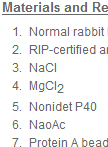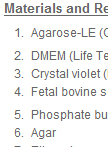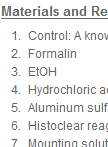往期刊物2012
卷册: 2, 期号: 13
生物化学
Measurement of Liver Triglyceride Content
肝脏三磷酸酯含量的测定
This assay is designed to measure relative lipid accumulation of experimental treatments compared to controls. The reagent measures the concentration of glycerol released after lysing the cells and hydrolyzing the triglyceride molecules. The triglyceride concentration can then be determined from the glycerol values.
RNP-IP (Modified Method)-Getting Majority of RNA from RNA Binding Protein in Cytoplasm
核糖核蛋白-免疫共沉淀(改进方法)—从细胞质所包含的RNA结合蛋白中分离大部分的RNA
Post-transcriptional regulation of gene expression is a ribonucleoprotein (RNP)-driven process, which involves RNA binding proteins (RBPs) and noncoding RNAs that regulate splicing, nuclear export, subcellular localization, mRNA stability and translation. mRNAs encoding proteins that function in a particular cell process or pathway can be found within a unique mRNP complex, which consists of mRNA and RNP. This provides valuable information regarding not only known components of a particular process or pathway, but importantly, leads to the identification of novel components representing potential therapeutic targets and biomarkers. In addition to those targets identified by pathway expansion, the specific RBPs (RNA binding proteina) regulating RNA functions may be potential therapeutic targets in their own right. RNP-IP is a technology that allows the isolation and identification of mRNAs, microRNAs and protein components of RNP complexes from cell extracts using antibodies to RBPs. Once purified, the RNAs present in the complex are analyzed to identify the target mRNAs using various molecular biology tools such as RT-PCR, gene expression analysis based on microarray technology (chip analysis), or sequencing. Using this modified method will get more RNA existing in cytoplasm. This method does not require a pre-clear step and getting the supernatant for western blot is different from the original method.
癌症生物学
Soft–Agar colony Formation Assay
软琼脂克隆形成实验
Any anchorage–independent growth of tumor cells is estimated by a soft–agar colony formation assay. This protocol provides a general workflow for establishing a soft-agar colony formation assay.
细胞生物学
Iron - Prussian Blue Reaction - Mallory’s Method
铁-普鲁士兰反应法- Mallory’s 方法
Purpose: To demonstrate ferric iron in tissue sections. Small amounts of iron are found normally in spleen and bone marrow. Excessive amounts are present in hemochromatosis, with deposits found in the liver and pancreas, hemosiderosis, with deposits in the liver, spleen, and lymph nodes.Principle: The reaction occurs with the treatment of sections in acid solutions of ferrocyanides. Any ferric ion (+3) in the tissue combines with the ferrocyanide and results in the formation of a bright blue pigment called 'Prussian blue" or ferric ferrocyanide.
微生物学
Immunofluorescence Analysis of Yeast Protein
酵母蛋白的免疫荧光分析
Many important regulatory proteins such as transcription factors are regulated through subcellular localization. Protein localization can be examined by fusing a GFP tag. However, GFP is relatively big in size, and potentially may affect correct protein localization. Several small tags have been developed, such as myc, HA or Flag. By using immunostain and fluorescence microscopy as described in this protocol, one can easily probe the regulation of a selected yeast protein with the application of the aforementioned small tags.
Yeast DNA Replication 2D Gel Protocol
适于二维琼脂糖凝胶电泳检测复制起始的酵母DNA提取
Two-dimensional agarose gel electrophoresis (2D gel) analysis is used extensively as a method to detect origins of replication. Here, I present a simplified method for the isolation of yeast genomic DNA for 2D gel analysis from a small number of yeast cells. This DNA isolation method is simpler and less time consuming than the traditional method that involves CsCl density gradient centrifugation. This method could be modified for 2D gel analysis in other organisms as well.








